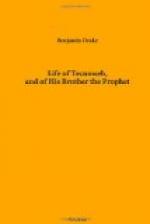Tecumseh and his party remained at the south nearly two years, traversing that region of country, visiting the different tribes of Indians, and engaging in the border forays which at that period were constantly occurring between the whites and the native possessors of the soil. He now determined to return home, and accordingly set out with eight of his party. They passed through western Virginia, crossed the Ohio near the mouth of the Scioto, and visiting the Machichac towns on the head waters of Mad River, from thence proceeded to the Auglaize, which they reached in the fall of 1790, shortly after the defeat of general Harmar, having been absent from Ohio upwards of three years.
CHAPTER III.
Tecumseh attacked near Big Rock by some whites under Robert M’Clelland—severe battle with some Kentuckians on the East Fork of the Little Miami—attack upon Tecumseh in 1793, on the waters of Paint creek—Tecumseh present at the attack on fort Recovery in 1794—participates in the battle of the Rapids of the Maumee, in 1794.
From the period of his return, until August of the following year, 1791, Tecumseh spent his time in hunting. In the autumn of this year, when information reached the Indians, that general St. Clair and his army were preparing to march from fort Washington, into their country, this chief headed a small party of spies, who went out for the purpose of watching the movements of the invading force.[A] While lying on Nettle creek, a small stream which empties into the Great Miami, general St. Clair and his army passed out through Greenville to the head waters of the Wabash, where he was defeated. Tecumseh, of course, had no personal participation in this engagement, so creditable to the valor of the Indians, and so disastrous to the arms and renown of the United States.
[Footnote A: Stephen Ruddell.]
In December, 1792, Tecumseh, with ten other warriors and a boy, were encamped near Big Rock, between Loramie’s creek and Piqua, for the purpose of hunting. Early one morning, while the party were seated round the fire, engaged in smoking, they were fired upon by a company of whites near treble their number. Tecumseh raised the war-whoop, upon which the Indians sprang to their arms, and promptly returned the fire. He then directed the boy to run, and in turning round a moment afterwards, perceived that one of his men. Black Turkey, was running also. He had already retreated to the distance of one hundred yards; yet such was his fear of Tecumseh, he instantly obeyed the order to return, indignantly given him, and joined in the battle. Two of the whites were killed—one of them by Tecumseh—before they retreated. While pursuing them Tecumseh broke the trigger of his rifle, which induced him to give up the chase, or probably more of the whites would have fallen. They were commanded by Robert M’Clelland. Tecumseh lost none of his men; two of them, however, were wounded, one of whom was Black Turkey.[A]




